
The Noctuidae, commonly known as owlet moths, cutworms or armyworms, are a family of moths. They are considered the most controversial family in the superfamily Noctuoidea because many of the clades are constantly changing, along with the other families of the Noctuoidea. It was considered the largest family in Lepidoptera for a long time, but after regrouping Lymantriinae, Catocalinae and Calpinae within the family Erebidae, the latter holds this title now. Currently, Noctuidae is the second largest family in Noctuoidea, with about 1,089 genera and 11,772 species. This classification is still contingent, as more changes continue to appear between Noctuidae and Erebidae.

Noctuoidea is the superfamily of noctuid or "owlet" moths, and has more than 70,000 described species, the largest number of any Lepidopteran superfamily. Its classification has not yet reached a satisfactory or stable state. Since the end of the 20th century, increasing availability of molecular phylogenetic data for this hugely successful radiation has led to several competing proposals for a taxonomic arrangement that correctly represents the relationships between the major lineages.

The Calpinae are a subfamily of moths in the family Erebidae described by Jean Baptiste Boisduval in 1840. This subfamily includes many species of moths that have a pointed and barbed proboscis adapted to piercing the skins of fruit to feed on juice, and in the case of the several Calyptra species of vampire moths, to piercing the skins of mammals to feed on blood. The subfamily contains some large moths with wingspans longer than 5 cm (2 in).

Chetone is a genus of tiger moths in the family Erebidae. The genus was erected by Jean Baptiste Boisduval in 1870.
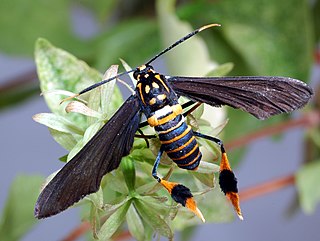
Horama is a genus of tiger moths in the family Erebidae first described by Jacob Hübner in 1819.
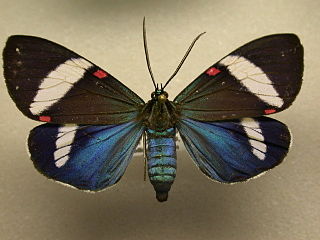
Hypocrita is a genus of tiger moths in the family Erebidae. The genus was erected by Jacob Hübner in 1807.
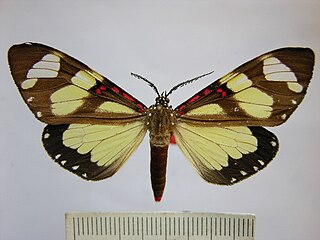
Phaloe is a genus of moths in the subfamily Arctiinae. The genus was erected by Félix Édouard Guérin-Méneville in 1838.

Cocytia is a genus of moths in the family Erebidae. It is monotypic, being represented by the single species, Cocytia durvillii, an uncommon day-flying moth found in lowland areas of the Moluccas, Aru, and New Guinea. The species has clear wings bordered with black, with an orange patch at the base of each forewing and long antennae, thicker at the outer end. Both the genus and species were first described by Jean Baptiste Boisduval in 1828.

Drasteria is a genus of moths in the family Erebidae.
Arachnis dilecta is a moth of the family Erebidae. It was described by Jean Baptiste Boisduval in 1870. It is found in Mexico and Honduras.

The Pericopina is a subtribe of tiger moths in the family Erebidae. The subtribe was described by Francis Walker in 1869.
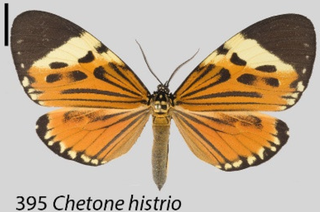
Chetone histrio, or Boisduval's tiger, is a moth of the family Erebidae. It was described by Jean Baptiste Boisduval in 1870. It is found in Honduras, Guatemala and Peru.

Chetone ithomia is a moth of the family Erebidae. It was described by Jean Baptiste Boisduval in 1870. It is found in Nicaragua and Costa Rica.
Chetone phaeba is a moth of the family Erebidae. It was described by Jean Baptiste Boisduval in 1870. It is found in Guatemala.

Dysschema arema is a moth of the family Erebidae first described by Jean Baptiste Boisduval in 1870. It is found in Nicaragua, Venezuela, Peru, Brazil and Ecuador.

Dysschema magdala is a moth of the family Erebidae. It was described by Jean Baptiste Boisduval in 1870. It is found in Guatemala, Costa Rica and Panama.
Hyalurga sora is a moth of the family Erebidae. It was described by Jean Baptiste Boisduval in 1870. It is found in Mexico, Guatemala and Panama.
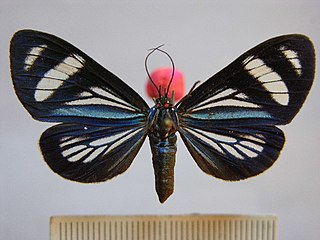
Hypocrita bicolora is a moth of the family Erebidae. It was described by Sulzer in 1776. It is found in Panama.

Hypocrita chalybea is a moth of the family Erebidae. It was described by Erich Martin Hering in 1925. It is found in Bolivia and Ecuador.
Hypocrita escuintla is a moth of the family Erebidae. It was described by William Schaus in 1920. It is found in Guatemala.
















